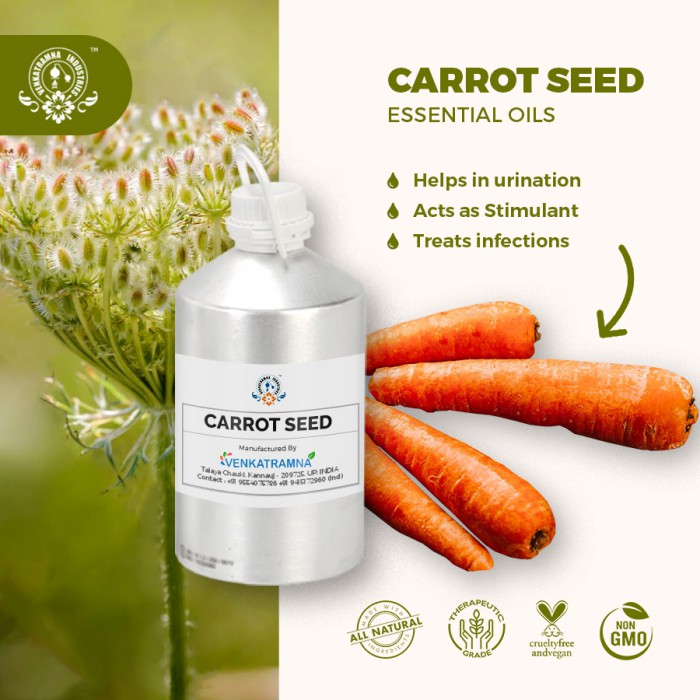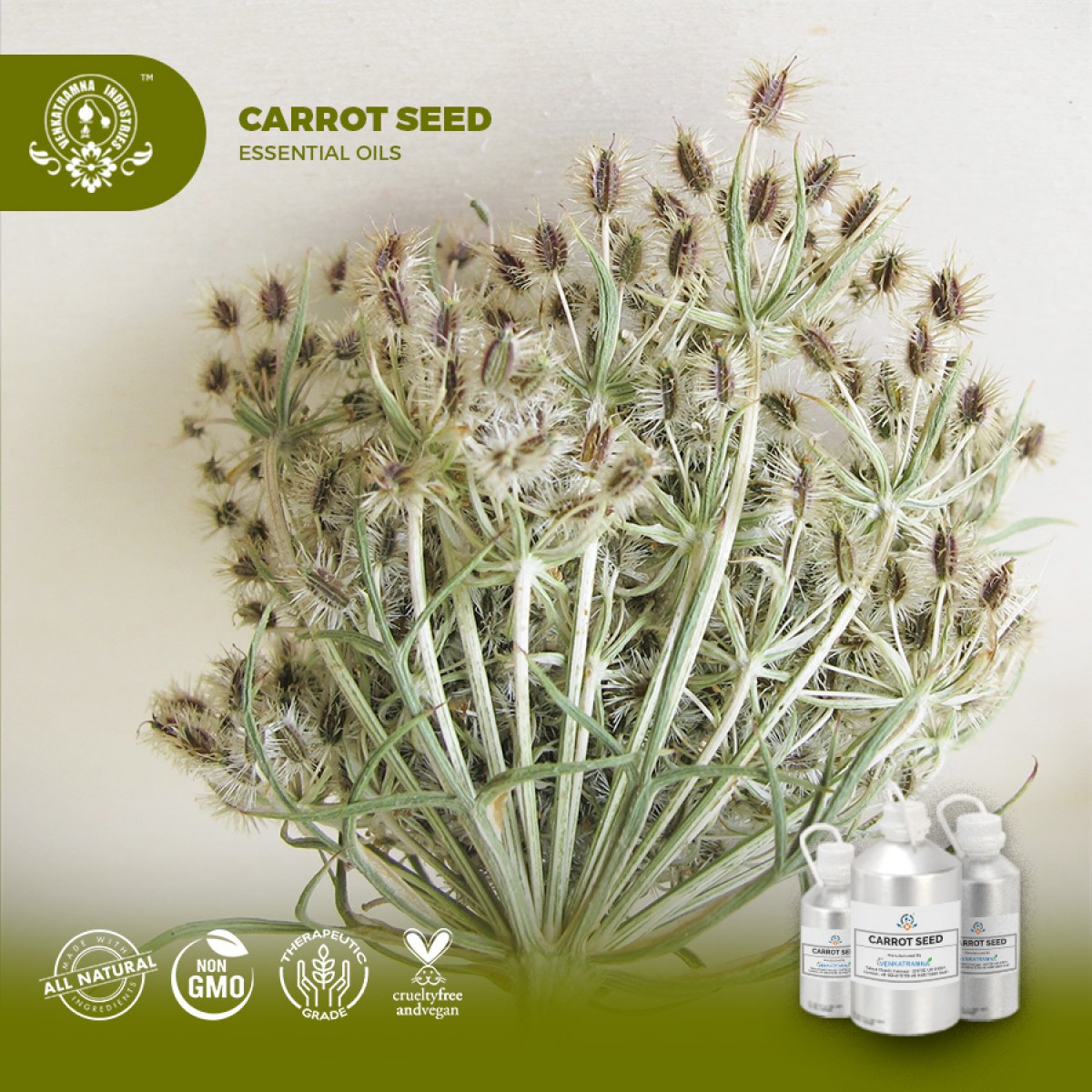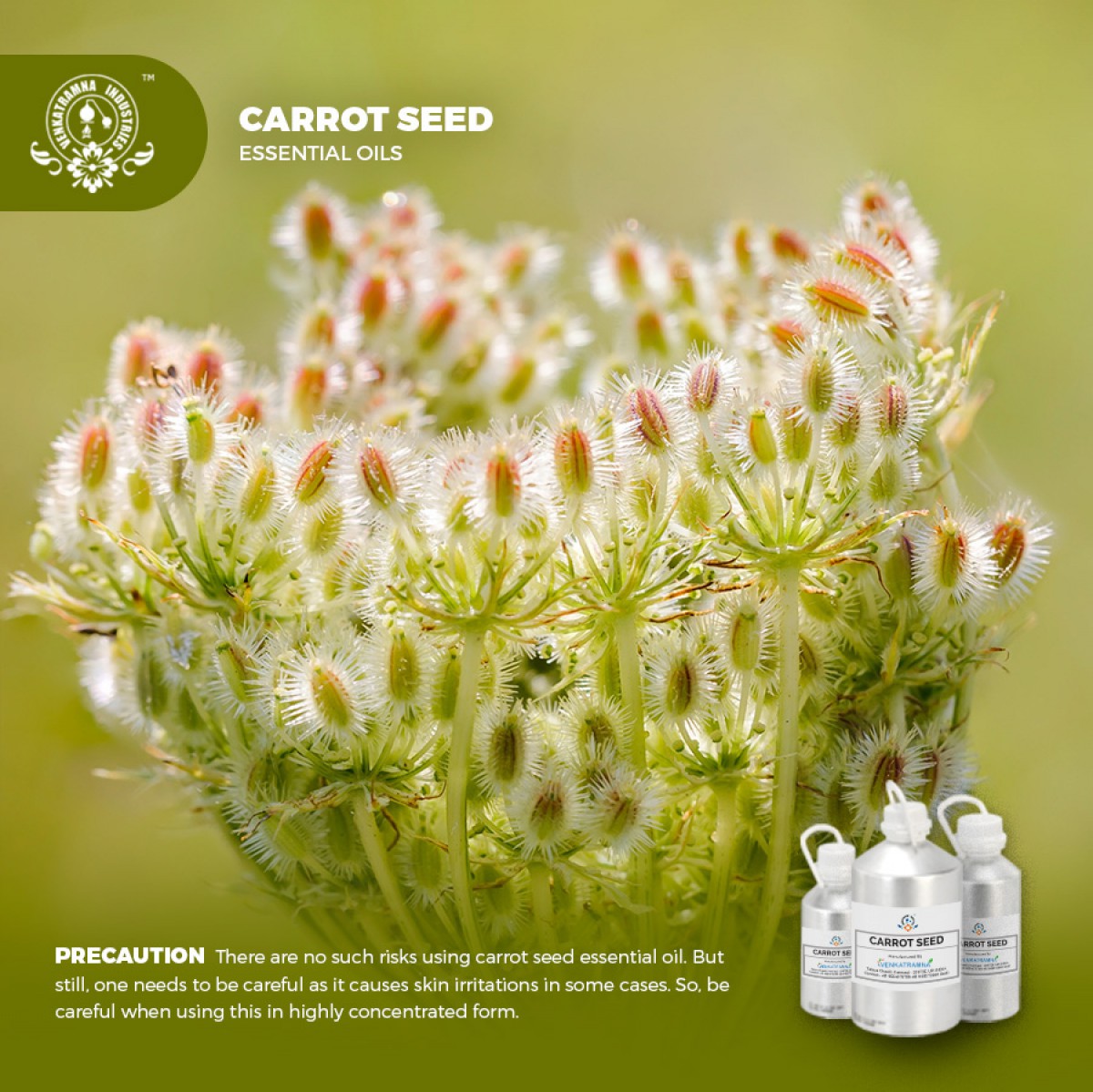Botanical Name: Daucus carota L. Common name: Bird's nest, bishop's lace, and Queen An Read More
|
Botanical Name: |
Daucus carota L. |
|
Common name: |
Bird's nest, bishop's lace, and Queen Anne's lace, Carrot, Gazar |
|
Plant family: |
Apiaceae |
|
Genus: |
Daucus |
|
Appearance/Color: |
Pale yellow to amber liquid with a thin viscosity. |
|
Odor: |
Middle note with a
medium aroma. It secures such aroma due to the strong woody, musky and earthy
scent. |
|
Blends With: |
Rosewood, frankincense, cypress, geranium and lavender |
|
Origin |
|
Carrot Seed Essential Oil is
derived from the dried seeds of the Daucus carota botanical, more commonly
known as the Wild Carrot or “Queen Anne’s Lace,” as it is referred to in
Europe. Carrot Seed Essential Oil is commonly mistaken for both Carrot Seed
Carrier Oil and Carrot Carrier Oil. The former carrier oil is obtained by
infusing a vegetable oil with cold-pressed Wild Carrot seeds, while the latter
is the result of infusing a vegetable oil with macerated Wild Carrot or Carrot
root then straining it. Thus, both are infused oils, though one is infused with
the seeds and the other with the root. The essential oil, however, is commonly
steam distilled from the seeds.
Carrot is the one of the major
vegetable crops cultivated worldwide. The domesticated types are divided into
two groups: the Eastern or Asian carrots (var. atrorubens), with mainly purple
and yellow roots; and the Western carrots (var. sativus) with mainly orange
roots. Carrots were thought to be domesticated in Afghanistan as the primary
centre of diversity and they were spread over Europe, Asia and the
Mediterranean area, and the origin of western cultivated carrots were thought
to be in the Asia Minor Centre, primarily Turkey.
Carrot Seed Oil has found uses in traditional Chinese medicine, which applies it as a bath or massage oil to address muscle pain or as an effective treatment for intestinal ailments such as dysentery and worms. It is also traditionally used in the manufacturing of perfumes to contribute its woody nuance to scents that are “Oriental” and “aldehydic.” When used in other cosmetics, it is a traditional and popular moisturizing agent for all-purpose body lotions.
DISCLAIMER
The complete range of conditions
or methods of use are beyond our control therefore we do not assume any
responsibility and expressly disclaim any liability for any use of this
product. Information contained herein is believed to be true and accurate however,
all statements or suggestions are made without warranty, expressed or implied,
regarding accuracy of the information, the hazards connected with the use of
the material or the results to be obtained from the use thereof. Compliance
with all applicable federal, state, and local laws and local regulations
remains the responsibility of the user.
The FDA has not evaluated the
statements on this website. No claims are made by Venkatramna Industries as to
the medicinal value of any products from vriaroma.com or by us. The information
presented here is for educating our customers about the traditional uses of
essential oils and is not intended to diagnose, treat, cure, or prevent any
disease. You are responsible for understanding the safe application of these products.
If you have any questions, please call or email us for further information.
As per NAHA guidelines, New Directions Aromatics
(NDA) does not recommend the ingestion of essential oils. It is imperative to
consult a medical practitioner before using Essential Oils for therapeutic
purposes. Pregnant and nursing women and those taking prescription drugs are
especially advised not to use this product without the medical advice of a
physician. The oil should always be stored in an area that is inaccessible to
children, especially those under the age of 7.
Carrot seed oil is a type of
essential oil. It’s extracted via steam distillation from the seeds of the Daucus
carota plant. This flowering plant, known for its white blossoms and
carrot-scented roots, is also called wild carrot and Queen Anne’s lace. Carrot
seed oil is sometimes confused with carrot oil, which is made from a mixture of
crushed carrot roots immersed in a carrier oil, such as olive or coconut oil.
Carrot oil isn’t an essential oil, however. Cold pressed carrot seed oil is
cold pressed from the carrot seeds, and it’s used in cosmetics for anti-aging
properties in skin care. Carrot seed essential oil has shown antibacterial,
antifungal, anti-inflammatory, and antioxidant properties.
Carrot Seed Oil in Pharma
The ethnobotanical uses of this
species also included applications in the treatment of cough, diarrhea,
dysentery, cancer, malaria, tumors, as an antiseptic, abortifacient,
aphrodisiac, carminative, stimulant, stomachic and tonic. Daucus carota was
used by the Ancient Egyptians as a stimulant, carminative, diuretic,
anthelmintic and as a decoction for infantile diarrhea
Essence of Carrot Seed Oil
Daucus carota was cultivated for
the enlarged fleshy taproot, eaten as a raw vegetable or cooked in many dishes.
Eaten sliced, diced, cut up, or shoe-stringed, carrots were used in many mixed
vegetable combinations. They were sold in bunches, or canned, frozen, or dehydrated.
They may be baked, sauteed, pickled, and glazed, or served in combination with
meats, in stews, roasts, soups, meat loaf or curries. Roasted carrot was used
as coffee substitutes. Essential oil was used to flavor liqueurs and perfumes.
Seeds were aromatic, carminative, diuretic, emmenagogue, stimulant, and were
used for dropsy, chronic dysentery, kidney ailments, worms, as aphrodisiac,
nervine tonic, and for uterine pain. Roots were refrigerant and used in
infusion for threadworm, as diuretic and eliminating uric acid.
Used in aromatherapy
applications, Carrot Seed Oil is known to have stimulant properties that
enhance circulation as well as brain and nerve functions. It boosts energy
levels and promotes alertness. By stimulating the release of digestive fluids
and enzymes, hormones, and the muscular contractions of the intestines, it
maintains the efficient movement of the digestive system and the metabolism.
COMMON USAGE
·
Antibacterial
·
Antifungal
·
Antioxidant
·
Anti-aging
·
Gastroprotective
·
Anti-inflammatory
Ingredients:
|
S.No |
Key Constituents |
Strength (%) |
|
1 |
a-pinene |
0.9-11.2 |
|
2 |
Carotol |
36.1-73.1 |
|
3 |
b-caryophyllene |
0.7-5.6 |
|
4 |
Dauca-4,8-diene |
1.6-5.9 |
|
5 |
sabinene |
0-3.9 |
|
6 |
(E)-dauc-8-en-4b-ol |
1.7-4.1 |
|
7 |
b-bisabolene |
1.5-3.1 |
|
8 |
Geranyl acetate |
0-3.7 |
|
9 |
Caryophyllene oxide |
0.3-2.8 |
|
10 |
Geraniol |
0-2.2 |
|
11 |
(E)-b-farnesene |
1.6-2.5 |
|
12 |
(E)-a-bergamotene |
0.9-1.9 |
|
13 |
b-pinene |
0.3-1.5 |
|
14 |
Daucol |
1.2-1.7 |
|
15 |
()-limonene |
0.4-1.5 |
|
16 |
b-myrcene |
0.4-1.3 |
|
17 |
(Z)-a-bergamotene |
0-1.1 |
|
18 |
b-selinene |
0-1.1 |
TOXICOLOGICAL
INFORMATION
Safety Summary
·
Hazards: Not known.
·
Contraindications: Prior to using Carrot Seed
Oil, a skin test is recommended.
Organ Specific Effects
·
Adverse skin reactions: cause skin
sensitivity.
·
Acute toxicity: No information found
·
Carcinogenic/anticarcinogenic potential: No
Information Available
Systemic Effects
·
Skin corrosion / irritation: Photo-toxic.
·
Serious eye damage / irritation: Liquid may be irritating
to eyes and skin.
·
Germ Cell Mutagenicity No additional data
available.
·
Carcinogenicity No additional data available.
·
Reproductive toxicity No additional data
available.
·
STOT-single exposure No additional data
available.
·
STOT-repeated exposure No additional data
available.
·
Aspiration hazard No additional data available.
·
Photo-toxicity: cause skin sensitivity upon sun
exposure.
ECOLOGICAL
INFORMATION
·
Toxicity: Very toxic to aquatic organisms, may
cause long term adverse effects in the aquatic environment.
·
Persistence and degradability: Biodegradable
·
Bio-accumulative potential Bioaccumulation is
unlikely
·
Mobility in soil Unknown





 MSDS-Carrot.pdf
MSDS-Carrot.pdf




